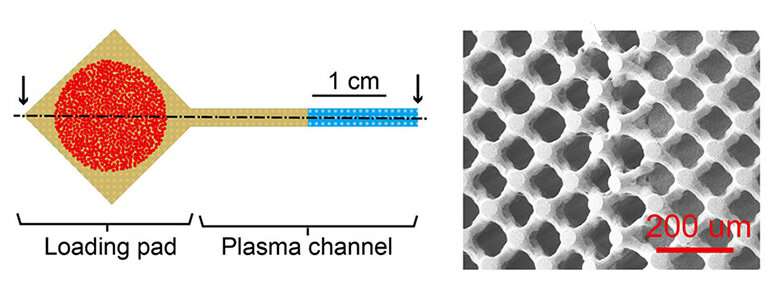The layout of the filter and a close-up of the surface detail. Clotted blood cells are indicated in red. Plasma filling up the channel is indicated in yellow. And the blue section indicates the empty remainder of the channel as the plasma fills it in. Credit: KTH Royal Institute of Technology
A new synthetic paper for finger prick blood tests could provide accurate point-of-care diagnostics for cancer, COVID-19 and other serious diseases. Researchers at KTH Royal Institute of Technology say the innovation allows detection of important biomarker proteins that might otherwise evade the blood plasma screening process.
There are proteins in your blood that cannot be found using today's rapid diagnostics, even though these could serve as important biomarkers that tell the doctor that you are at risk for cancer, cardiovascular disorders or other serious medical issues.
One reason is that these proteins are found only in low levels in the blood, which is why tests which require separation of blood from plasma need to ensure that no proteins are lost in the process.
Wouter van der Wijngaart, a professor in micro and nanosystems at KTH, says that the synthetic test paper created by the KTH research team recovered at least 10 percent more proteins from plasma than is possible with current filtering methods. The best current filters enable recovery of 70 percent of protein, he says.
"This could in theory be used for any type of protein, such as antibodies," van der Wijngaart says. "One could easily imagine adding a test line for COVID-19 antibodies in the plasma strip."
The difference starts with the surface of the filter, he says.
"Blood filters not only keep out blood cells, but they also bind protein in the blood," he says. "This is a problem because filters have a large internal surface, hence a lot of binding sites for protein."
By contrast, the synthetic paper's relatively low internal surface area—composed of a micro-scale scaffold of interlocked pillars—binds comparatively little protein.
The filter's design consists of a square area that contains blood clotting agent, adjoined by a channel that collects the plasma. Blood is dropped on the square area, where the clotting agent forces the blood to clot, and the blood cells become stuck there. The plasma flows into the channel through capillary action—a natural phenomenon resulting from the interplay between two kinds of forces, cohesion and adhesion (the same force that enables water to flow into a plant through its roots).
Van der Wijngaart says the plasma extractor could be integrated with conventional testing. Because they rely on the natural force of capillary action, lateral-flow test strips are self-contained and autonomous, he says. The unit production cost of the material is only about 2 to 4 times that in commercial tests, the researchers estimate.
The results were reported in Analytical Chemistry.
More information: Weijin Guo et al. Synthetic Paper Separates Plasma from Whole Blood with Low Protein Loss, Analytical Chemistry (2020). DOI: 10.1021/acs.analchem.0c01474
Journal information: Analytical Chemistry
Provided by KTH Royal Institute of Technology
























